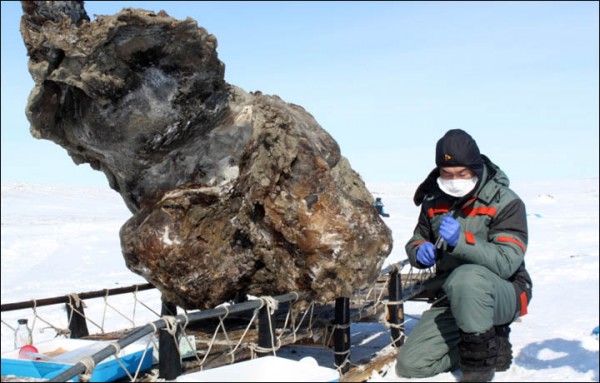Frozen Woolly Mammoth Found in Siberia to be Cloned in Korea
| Staff Reporter | | Nov 18, 2014 08:11 AM EST |
(Photo : Semyon Grigoriev) A portion of the female woolly mammoth found in Siberia with liquid blood is still present in the animal.
Scientists recently discovered an extinct woolly mammoth with blood still present in its veins, a discovery that opens the door to cloning.
This process is called "de-extinction" and it theoretically allows researchers to "resurrect" a number of extinct animal species. Ancient animals such as the woolly mammoth, the dodo bird and the carrier pigeon are some species researchers are considering bringing back to life.
Like Us on Facebook
In May 2013, Russian paleontologists uncovered the frozen corpse of a woolly mammoth almost perfectly preserved on an island off the Siberian coast.
The team from Northeastern Federal University in Yakutsk detailed the process of de-extinction. They said their aim is to search for remaining living cells that can prove to be the most pivotal and difficult step in cloning.
The cloning procedure will be performed in Korea under the Sooam Foundation that has extensive experience with animal cloning, especially with dogs.
The frozen wooly mammoth is apparently female and around 60 years old. She's the oldest woolly mammoth found and her body and flesh are almost all intact.
Biologists presume this animal lived around 10,000 to 15,000 years ago. Her cause of death is likely to be from drowning and the water froze so quickly over her body it preserved her stomach and the lower half of her body. Some portions of the animal's back were eaten by predators before the whole body froze.
According to expedition leader Semyon Grigoryev from the Northeastern Federal University, the preserved insides are so pristine that blood remained in liquid form and the muscle tissue remained red like the color of fresh meat.
Woolly mammoths are among several species of mammoths and a relative of modern elephants. They stand around 10 feet tall, which is the same size of the African elephant. Due to climate change, global warming thaws out these ancient frozen creatures and it's now becoming easier for paleontologists to uncover woolly mammoths in Siberia.
This process will be featured in a TV show called How to Clone a Woolly Mammoth that will premiere on the Smithsonian Channel this November 29. The show will also shed light on the ethical issues raised by cloning.
TagsFrozen Woolly Mammoth Found in Siberia to be Cloned in Korea, woolly mammoth, mammoths, Korea, Siberia, frozen woolly mammoth siberia clone, woolly mammoth clone, animal cloning, De-extinction, how to clone a woolly mammoth, smithsonian channel
©2015 Chinatopix All rights reserved. Do not reproduce without permission
EDITOR'S PICKS
-

Did the Trump administration just announce plans for a trade war with ‘hostile’ China and Russia?
-

US Senate passes Taiwan travel bill slammed by China
-

As Yan Sihong’s family grieves, here are other Chinese students who went missing abroad. Some have never been found
-

Beijing blasts Western critics who ‘smear China’ with the term sharp power
-

China Envoy Seeks to Defuse Tensions With U.S. as a Trade War Brews
-

Singapore's Deputy PM Provides Bitcoin Vote of Confidence Amid China's Blanket Bans
-

China warns investors over risks in overseas virtual currency trading
-

Chinese government most trustworthy: survey
-

Kashima Antlers On Course For Back-To-Back Titles
MOST POPULAR
LATEST NEWS
Zhou Yongkang: China's Former Security Chief Sentenced to Life in Prison

China's former Chief of the Ministry of Public Security, Zhou Yongkang, has been given a life sentence after he was found guilty of abusing his office, bribery and deliberately ... Full Article
TRENDING STORY

China Pork Prices Expected to Stabilize As The Supplies Recover

Elephone P9000 Smartphone is now on Sale on Amazon India

There's a Big Chance Cliffhangers Won't Still Be Resolved When Grey's Anatomy Season 13 Returns

Supreme Court Ruled on Samsung vs Apple Dispute for Patent Infringement

Microsoft Surface Pro 5 Rumors and Release Date: What is the Latest?










